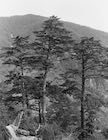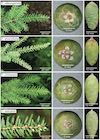Conservation Status

Tsuga ulleungensis
G. P. Holman, Del Tredici, Havill, N. S. Lee, and C. S. Campb. (2017)
Common names
Ulleungdo hemlock (Holman et al. 2017).
Taxonomic notes
Type: South Korea. Ulleungdo. 2 June 1917, E. H. Wilson 8529. No synonyms.
This species is a member of the Asian clade of Tsuga. It was described in 2017 as a new taxon endemic to Ulleungdo (울릉도), a volcanic island in the Sea of Japan about 140 km east of the Korean Peninsula. These trees had formerly been treated as Tsuga sieboldii and based on morphological evidence alone, the new taxon might reasonably be placed into synonymy with that species. However, it does show consistent morphological differences from T. sieboldii (and other northeast Asian Tsuga), and nuclear DNA evidence places it in a clade with the Japanese species T. diversifolia and T. sieboldii. Chloroplast DNA, however, places it in a clade with T. diversifolia, while T. sieboldii and T. chinensis share a distinct clade. It appears that at some point, T. sieboldii captured the chlorplast DNA of T. chinensis, a phenomenon that post-dated the divergence of the Ulleungdo hemlocks. This is a powerful reason to treat T. ulleungensis as a good species rather than as a variety or synonym of T. sieboldii. Ulleungdo has been a forested island for about 1.7 million years and this provides a limiting date for the species' divergence from T. sieboldii (Holman et al. 2017).
Description
Trees to 22 m tall and 80 cm dbh. Twigs glabrous, 1–1.5 mm diameter. Buds: 2–3 × 1.8–2.4 mm wide, globular or obovoid, glabrous; scales orbicular, dark brown, with crenate margins. Leaves linear, 8-14 × 1.7-2.1 mm with 0.9-1.6 mm petioles; base attenuate; margins entire and slightly thickened; apex emarginate; hypostomatic, with stomata in two broad, dull white to buff bands on either side of midrib, each band with mostly 8 rows of stomata, decreasing to 2–3 proximally, and 4–5 distally; with a single resin canal, 0.4–0.7 mm diameter at midpoint of leaf. Pollen cones 4–8 mm long, reddish-purple. Young seed cones purple; bracts broader than long, with more or less crenulate margins; apex with a bifid apical projection 0.5 times as long as bract body. Mature seed cones globular to ovoid, 19–30 × 18–26 mm when open; on 1–2 mm long peduncles; cone scales 20–26, 9–15 × 10–15 mm. Seeds 4–5.5 × 2–2.5 mm, with wings 4.5–8.5 × 3.4–4.2 mm wide (Holman et al. 2017).
T. diversifolia is readily distinguished by its hairy twigs and pure white stomatal bands. T. sieboldii is distinguished by thicker leaf resin canals, and erose to denticulate cone-scale bract margins (Holman et al. 2017).
Distribution and Ecology
South Korea: Ulleungdo, a volcanic island. Found on north-facing slopes at elevations of 310-500 m, primarily on well-drained rocky ridges in forest dominated by Pinus parviflora with secondary Acer pseudosieboldianum, Camellia japonica, and Fagus multinervis. Although the IUCN has not (as of 2020) recognized this taxon, it would be classed as "critically endangered" due to its restricted range (Holman et al. 2017).
Remarkable Specimens
Ethnobotany
Observations
Remarks
The epithet refers to Ulleungdo, the only known native habitat.
The discovery and naming of this species arose as a consequence of efforts to control the ongoing hemlock woolly adelgid infestation that is destroying native populations of Tsuga canadensis and T. caroliniana, an engaging story told by del Tredici (2018).
Citations
Del Tredici, Peter. 2018. Behind the scenes on naming a new hemlock species. Arnoldia 76(2):2-9.
Holman, G., P. Del Tredici, N. Havill, N. S. Lee, R. Cronn, K. Cushman, S. Mathews, L. Raubeson, and C. S. Campbell. 2017. A new species and introgression in eastern Asian hemlocks (Pinaceae: Tsuga). Systematic Botany. 42(4):733–746.
See also
Ahn, C., Han, J., Kim, Y. et al. 2018. Propagation and cryopreservation of Ulleungdo hemlock (Tsuga ulleungensis) via somatic embryogenesis. Trees 32:1801–1808.



